Last week we got wind of a customer project - called Mechanek - that caught our attention. We reached out to Mark Gallagher, one of the creators, and asked him to share more about the Mechanek, how it came about, and how it has the potential to save lives and reduce injuries for race car drivers. Thanks for sharing your work, Mark!
Can you tell us a little bit about yourself and what you do?
Mechanek was a Mechanical Engineering Senior Design Project at the University of Pennsylvania. The team was made up of myself, Kristopher Li, Anthony Terracciano, and Bahram Banisadr. Bahram, Kris and I are currently Master's students at UPenn. We also had a great advisor - Dr. Matthew Maltese, who works at the Children's Hospital of Philadelphia conducting biomechanics research focusing on how to make motor vehicle crashes safer.
All photos courtesy of mechanek.com
How does Mechanek work?
On a HANS device (currently the safety standard mandated by SFI, FIA, and NASCAR), motion of a driver's head in the case of a crash is limited by two tethers. These tethers prevent overextension and flexion of the neck in a crash that can cause a type of injury called basal skull fracture, which is often fatal. Mechanek replaces the static tethers of a HANS device with tethers on motorized spools.
The tethers are designed to move in and out as the driver moves his or her head. Unlike a HANS device, which can limit a driver's range of motion and field of view, Mechanek does not restrict the driver's field of view at all, offering greater situational awareness while driving. Another benefit of the motorized tethers is that there never needs to be any slack. To provide the HANS user with some range of motion, a small amount of slack is allowed in the tethers. In the case of a crash, this results in a violent impact when that slack is rapidly taken up as the driver's head moves forward. Mechanek maintains a small amount of tension in the tethers at all times by using a current-controlled feedback loop on the motors. We were fortunate to be able to conduct comparison tests of the HANS device and Mechanek at a full-scale crash test facility called Calspan in Buffalo, NY. We conducted two 40g impact tests, and Mechanek showed a 30% reduction in the risk of concussion and mild traumatic brain injury (measured by the Head Injury Criterion [HIC]) and a 20% reduction in the risk of basal skull fracture (measured by the NIJ [Neck Injury Criterion]).
In addition to decreasing the risk of head and neck injury and offering a drivers a greater range of motion, Mechanek also interfaces with a vehicle's on-board diagnostics to attempt to predict and respond to driver loss of control before an impact happens. We're using several on-board accelerometers, as well as an OBD-II board, to look at things like brake and throttle position, wheel slip sensors, and airbag deployment sensors to try to determine whether a crash is impending and potentially move the driver's head into a safer position before a crash happens.
What was the inspiration for Mechanek?
When our team was doing some of our initial need-finding and basic research, we saw the HANS device as an area where technology seemed to have not kept up with the rest of the industry. The HANS device was developed in the early 1980's, and it hasn't changed much since. Its developers have made some changes to increase drivers' range of motion and field of view, but these changes didn't do much to make the device any safer for drivers, and it's still a completely passive device. With Mechanek, we're looking to take advantage of all the data that modern race cars are collecting, and use it to help make racers safer.
How long did Mechanek take to complete, and what materials did you use?
We completed our first prototype of Mechanek within 8 months of starting the project. The first 3 months or so were dedicated to background research and design, and then we spent the next 5 months prototyping and manufacturing everything. One thing we're proud of is that a vast majority of the components on Mechanek were fabricated by us in Penn's machine shop. We have access to a great facility with CNC lathes, mills, 3D printers and other rapid prototyping tools that we made great use of.
SparkFun really saved us when it came to the electronics side of the project. The team was composed of entirely mechanical engineers, and we have some mechatronics experience, but we're definitely not experts - so SparkFun's breakout boards made things a lot easier. We used three different breakouts on the sensing side: a 16g accelerometer breakout (ADXL345), a 200g accelerometer breakout (ADXL377), and a SparkFun OBD-II UART board. All of these interfaced with an Intel Edison with the Arduino expansion board. We also did some of our early prototyping using the SparkFun Edison Blocks. SparkFun components really helped the crash detection and computation side of our project come together.
Where do you see Mechanek in the future?
In order to make Mechanek viable in the actual automotive racing field, it needs to become a lot lighter and more compact. Our first prototype was built very robustly to make sure it would make it through crash testing, but now we're working on making the package smaller. A lot of that will come from using alternate manufacturing techniques. Instead of milling most of the components from aluminum, casting them from magnesium or even using SLS could help us develop a geometry that is much lighter, more compact, and just as strong.
What would be your advice for someone making their own project?
I think it really helps to ask around for help. If you have an interesting project, a lot of people will be really willing to offer their time, experience, and resources. That can make a big difference to the success or failure of a project.
Thanks again Mark, and awesome work! If you have any questions about the Mechanek, Mark will be keeping an eye on the comments to answer them!
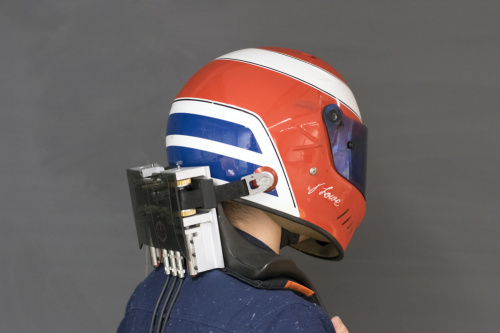
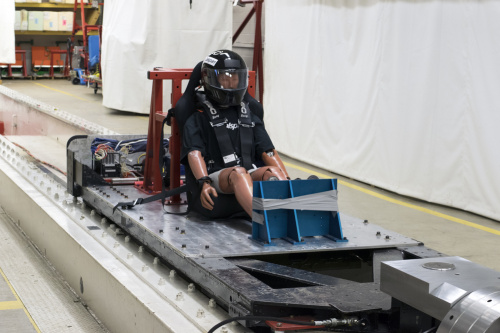
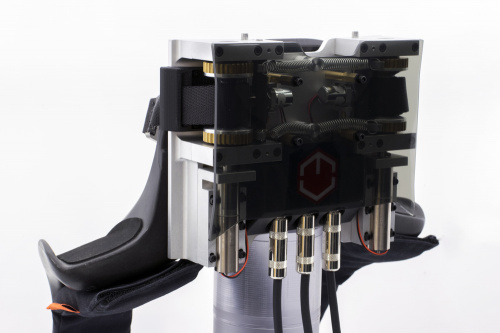
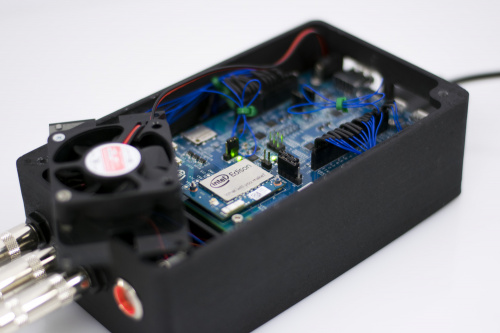


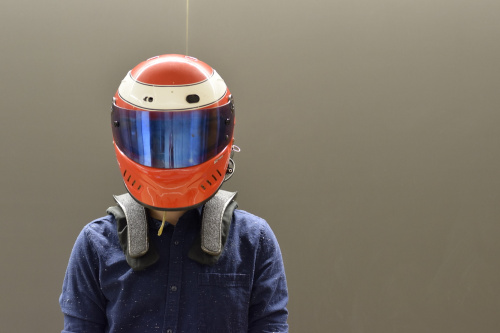







Magnesium probably isn't the best choice, given how energetically it will burn.
Also, is there a reason that it cant be mounted on the racing seat itself?
Thanks for the comment! The primary reason for not mounting Mechanek on the racing seat itself is that drivers need to be able to get out of the car quickly in the case of a crash. Like the HANS device, to exit the vehicle the driver needs only to remove the harness with Mechanek. If Mechanek were mounted to the seat, the driver would likely also need to remove the straps from the helmet, which would add time. This is something that many of the drivers we spoke to early on in the project were strongly against.
I have close familiarity with a wide number of motorsports, most prevalent being drag racing and different off road disciplines.
In drag racing and onroad this design wouldnt be that big of a deal. Off road is a different story however. Off road racing is jarring (meaning the device would have to know the difference between a crash and a mistimed jump for example), and can require the driver to exit the vehicle to do repairs, which means this thing is just in the way. Easy on/off would be important there for example.
Not knocking it in any, im going to keep a close eye on this because I think its a good progression on the HANS device, just a reminder that different disciplines may take some different approaches.
Really cool project!
Thanks!
Nice project, but this is basically a re-invented seatbelt pre-tensioner. Moreover, those are functionally quite a bit simpler, some even using pyrotechnics to tension the belts in the case of an impact - very important for a safety critical device. The fewer things that could fail, the better.
Also, you certainly don't want to put anything of a significant mass on the driver's neck/head. At the accelerations the race car drivers experience during the race this could be a major liability because it becomes a heavy "rock" tied to their neck. That would increase the strain on their neck muscles and potentially risk injury (you certainly don't want your safety device meant to prevent the driver from breaking their neck to actually break their neck ...). There is a good reason for why HANS is so mechanically simple - the mass of the device is of a paramount importance.
Hi! Thanks for checking out our project. You're right that Mechanek is mechanically inspired by seatbelt pre-tensioners. The idea of putting pyrotechnics that close to a driver's head though, was even more objectionable when we were completing some early surveys with drivers. In addition, the neck is a lot more fragile than the upper torso, and using motors gives us a lot more control over force applied to the head and neck.
With respect to the weight of the device, we agree that it's not practical in its current form. Just like a HANS device though, none of the weight is supported by the driver's neck - the weight is transmitted to the driver's shoulders and torso through the brace, and held in place by the harness. When the driver is strapped in to a race seat, there is no perceptible distance in weight when compared to a HANS device. In fact, Mechanek is more comfortable as there's no "hard stop" when the driver moves his/her head left and right. The primary concern with weight currently is that it is a significant addition high above the center of mass. In open wheel racing this is very frowned upon, in something like rally racing it's less of an issue. In future prototypes we're focusing on decreasing weight and re-packaging to make the overall device much smaller. This was just a first prototype, and we wanted to make sure it would survive crash testing!
Thanks for the comments. All feedback is appreciated.
Hello Mark,
Thanks for replying.
I didn't suggest to actually use pyros, that would probably not be a good idea for multiple reasons (imagine it firing around spilling fuel, even though the patrones are actually enclosed in a real pretensioner). There are several types of these pretensioners around - the one using a pyropatrone that activates in the case of crash (similar to airbags and controlled by the same system), then ones using electrical motors and finally a purely mechanical one (the oldest system) using springs. The point is to minimize electronics and moving parts to minimize the points of failure. That is where the seatbelt pretensioners as an inspiration for the design could be a good idea.
Re mass: careful, I was speaking about moving mass, not the static weight of the device (which is, indeed, supported by the shoulders). The moving mass comes into play when you have strong accelerations, especially lateral ones. The mere mass of the helmet is the reason why drivers specially train their neck muscles because otherwise they wouldn't be able to cope with the enormous centripetal forces produces by the helmet while cornering - that is the reason it is "frowned upon" in open wheel racing. In rallying the forces are smaller, but it is still significant, especially in a case of an accident like a rollover. So adding extra stuff in a place where it could add to this mass is a really poor idea.
One solution would be to displace the electronics and have it linked with a lightweight actuator on the HANS by a cable with a quick disconnect connector. The drivers use cables for their helmet microphones/headphones, intercoms or even medical sensors already, so this could be integrated with that in order to not require additional cable to be removed in an emergency. I would also move the (relatively heavy) actuators down, lower on the driver's back, closer to the driver's centre of mass, reducing the leverage it produces on the neck. That would need some engineering in order to keep the driver safely in the seat and comfortable, though.